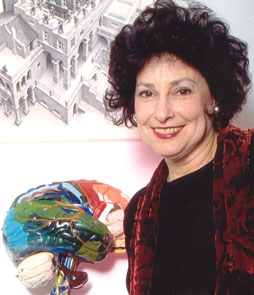Professor Sandra F. Witelson
The NewScientist article A Hands-On Approach to Studying the Brain, Even Einstein’s said
“Standing in her vaultlike walk-in refrigerator, Sandra F. Witelson pries open a white plastic tub that looks like an ice cream container. Skip to next paragraph Jim Ross for The New York Times Sandra F. Witelson in her laboratory with some of her specimens. There, soaking in diluted formaldehyde, is a gleaming vanilla-colored brain: the curvy landscape of hills and valleys (the gyri and sulci) that channeled the thoughts of the late mathematician Donald Coxeter, known as the man who saved geometry from near extinction in the 20th century.‘His brain is amazingly plump,’ Dr. Witelson says. She ought to know.
Here at McMaster University, where she is a neuroscientist with the Michael G. DeGroote School of Medicine, Dr. Witelson has a collection of 125 brains. They are all from Canadians: business people, professionals, homemakers, and blue- and white-collar workers.
By weighing her specimens, calculating their volumes and measuring their proportions, Dr. Witelson (pronounced WIT-il-son) investigates the relationship between brain structure and cognition, a focus of her research for three decades.
It was Dr. Witelson’s 1999 study of Albert Einstein’s brain that made headlines by revealing some remarkable features overlooked by other neuroscientists: the parietal lobe, the region responsible for visual thinking and spatial reasoning, was 15 percent larger than average, and it was structured as one distinct compartment, instead of the usual two compartments separated by the Sylvian fissure.”
Sandra F. Witelson, M.Sc., Ph.D., FRSC is Professor, Dept. of Psychiatry & Behavioral Neurosciences, Albert Einstein/Irving Zucker Chair in Neuroscience, Michael G. DeGroote School of Medicine, McMaster University, Canada.
Sandra researches the Neurobiological Basis of Cognition in Health & Disease in Men & Women: focusing on hemispheric functional specialization and language and spatial cognition; postmortem anatomy and in vivo MR Imaging; structure-function relationships in the human brain; developmental neurobiology, microscopic neuroanatomy and immunocytochemistry; sexual differentiation of the human brain in relation to behavior and lateralization; neurobiological basis of sexual orientation; neuroanatomical and neuropsychological aspects of congenital cognitive disorders; and human brain banks.
She coauthored The exceptional brain of Albert Einstein, A cognitive profile of homosexual men compared to heterosexual men and women, Left-handedness in homosexual men and women: Neuroendocrine implications, Anatomical development of the corpus callosum in humans: A review with reference to sex and cognition, Size of the human corpus callosum is genetically determined: an MRI study in mono and dizygotic twins, Sex differences in functional activation patterns revealed by increased emotion processing demands, and authored Neural sexual mosaicism: Sexual differentiation of the human temporo-parietal region for functional asymmetry.
Sandra is Fellow of the Royal Society of Canada.
Read The outer limits of the human brain, Bigger brain size matters for intellectual ability, and Witelson prize advances student’s interest in ophthalmology.
